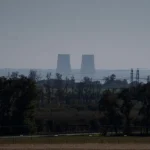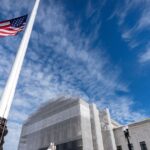

The Biden administration’s push for widespread electric vehicle adoption threatens to place significant strain on aging power grids, threatening capacity during hours of peak demand and raising the risk of blackouts.
To date, the administration has announced tens of billions of dollars in federal spending to help entice families and states to embrace electric vehicles as it seeks to meet its target of having electric vehicles make up 50% of new car sales by 2030.
MANCHIN THREATENS TO SUE TREASURY OVER ELECTRIC VEHICLE TAX CREDITS
The biggest incentives include the $7,500 consumer tax credit for electric vehicle purchases in the Inflation Reduction Act designed to mitigate high upfront costs for consumers, as well as the $7.5 billion in funding under the Bipartisan Infrastructure Law dedicated to building out a national network of 500,000 public EV charging stations.
An estimated 3.2 million EVs are on the roads in the United States today, representing approximately 1% of vehicles in the country.
That number is slated to rise sharply in the coming years: The Edison Electric Institute estimated that by 2030, the number of EVs in the U.S. is expected to grow to about 22 million vehicles — a massive increase that will correlate with a strong rise in demand on U.S. power grids.
But without proper planning, widespread adoption of electric vehicles could add severe strain to already-stressed U.S. power grids — threatening transformer blowouts, electricity shortages, and even requiring the use of costly new power plants to meet the heightened demand.
How much additional power EVs will require is difficult to quantify. A 2020 estimate from the Brattle Group suggested as much as $125 billion would need to be invested in grids to meet the demand.
That number includes $30 billion to $50 billion for additional power generation and grid storage, $15 billion to $25 billion for transmission and distribution upgrades, and $30 billion to $50 billion for EV chargers and infrastructure, the report found.
Otherwise, the threat of power shortages will become increasingly frequent.
The risks increase if grids fail to add the necessary transmission to bring clean energy resources online, if EV users fail to heed mitigation strategies such as charging their vehicles during the day, or if grid operators move too quickly away from fossil-fueled or “dispatchable” resources in an effort to decarbonize the grid.
Ronald Schoff, the director of the Electric Power Research Institute, told reporters this month that decarbonizing U.S. power grids while also ensuring that they can withstand growing EV demand is likely to prove a “daunting,” though not altogether impossible, challenge.
“In order to hit those kinds of figures, we see a rapid buildout of renewable energy — from the 230 gigawatts [of renewable power] we have today to over 600 gigawatts potentially by 2030,” Schoff said, citing ERPI’s modeling.
“We are effectively rebuilding an airplane that is in midflight,” he said.
“We are trying to switch the fuel, and we’re trying to change out the wings, the wheels, the engine, all as we go,” he added. “Which is possible — but it’s complicated.”
Why it matters
The supply-demand imbalance on U.S. power grids has been on stark display in recent years, especially in certain states — threatening rolling blackouts or fears of complete collapse.
Last September, a historic heat wave descended on California, bringing blistering triple-digit temperatures and pushing energy demand to a record of 52,000 megawatts.
Gov. Gavin Newsom (D-CA) declared a state of emergency, and the state’s grid operator activated an emergency conservation program that stretched beyond a week, successfully but narrowly avoiding more blackouts like those that roiled the state in 2020.
Earlier this year, federal regulators approved a request to extend the life of California’s Diablo Canyon Nuclear Power Plant — a once-unthinkable request from Newsom and other Democrats made in the name of reliability concerns.
Reliability concerns are also top of mind in Texas after a devastating 2021 winter storm caused 4.5 million Texans to lose power and a near-collapse of the state’s power grid.
As a result, state lawmakers are weighing new bills that would shift the state’s power generation away from renewables and toward natural gas, threatening its status as a wind and solar energy powerhouse and possibly driving up costs for consumers.
Proponents of the bills say adding more fossil-fueled or “dispatchable” generation to the grid will help protect against outages from other extreme weather events.
A team of researchers from the Massachusetts Institute of Technology said in a new report that it is necessary to develop “demand mitigation strategies” to help reduce EV strain on grids as the rate of adoption increases.
One key mitigation strategy is to invest in strategically located public chargers downtown and near workplaces to encourage charging during the day, when electricity demand is lower.
These need not be the faster, Level 2 variety chargers, the researchers said. Rather, they found that the addition of even slow public chargers at workplaces can sufficiently help reduce the strain on power grids.
Workplace chargers also help use renewable sources, such as solar power, which is often in abundant supply during the day, they noted.
Oftentimes, excess solar generation is wasted in the hours of peak generation because most grids lack the battery or storage capacity required to keep it online for very long in the evening.
Solar power oversupply during daylight hours can also cause fossil fuel-powered plants to reduce their power generation to maintain the supply-demand balance, thus resulting in a resource shortage during the evenings, when solar generation abruptly retires and household demand sharply increases — the phenomenon known as the “duck curve.”
And since workplace charging cannot be the sole source of charging, researchers also recommended “delayed home charging,” under which drivers would program their EVs to charge by a fixed amount overnight.
The delayed home charging solutions can eliminate peak demand from EVs by “well over 50%,” the report found.
Without these mitigation strategies, they said, as much as 20% more power generation would need to be installed for power grids to keep up with the added demand from EVs.
Failure to adopt such mitigation strategies would also increase electricity prices relative to today’s costs, thus raising costs of EVs over time compared to conventional gas-powered vehicles and “potentially providing a new barrier to further electrification of the transport sector,” they wrote.
A Stanford University study published last fall in the journal Nature Energy cited similar concerns.
Researchers found that rising levels of EV ownership in the West could cause electricity demand to increase by as much as 25% by 2035 overall, should drivers continue the dominant trend of charging their EVs in their homes at night.
In order to reduce the strain on grids, the Stanford report also called for “significant” investments to build out more public charging infrastructure, particularly downtown and near places of work.
California and other Western states should also consider adopting new time-of-use electricity pricing structures to encourage daytime charging, they added.
Their recommendations go beyond just the West Coast, where EV adoption is highest: They warned that similar supply-demand gaps are growing for all U.S. power grids as electrification spreads, particularly due to the rise in EV sales.
“All states may need to rethink electricity pricing structures as their EV charging needs increase and their grid changes,” the study’s lead author, Siobhan Powell, said in a statement.
The MIT researchers found that workplace charging during the day reduced grid demand during evening “peak hours” by a whopping 70% in New York and 80% in Dallas, the two locations it studied closely for the report.
Decarbonizing the grid
Increasing the share of EVs in the U.S. to 50% compared to the just 5% of EVs on the road today will require a “rapid” buildout of renewable energy resources and transmission to supply grids nationwide, according to researchers.
But that’s especially true the Biden administration hopes to deliver on its pledge to halve U.S. carbon emissions by 2030 compared to 2005 levels as part of the nation’s commitment under the Paris climate accord.
The U.S. transportation sector accounts for 27% of the nation’s greenhouse gas emissions, meaning that electrifying the fleet is key if the U.S. hopes to deliver on its goals of fighting climate change and meeting its target set under the Paris Agreement.
Doing this presents myriad challenges for utilities, generators, and grid operators, which must develop planning models that anticipate both the rise in energy generated by EVs and what the charging patterns will be, including during hours of peak demand.
“I think that’s one of the challenges,” said former Federal Energy Regulatory Commission Chairman Neil Chatterjee, who oversaw key efforts to help reconfigure and prepare power grids for electrification during his tenure.
“Charging at the workplace, charging cars during the day — that anticipates that you drive to work and park in at work,” he said. “And what if you’re in an urban environment, where parking your car at the office or plugging it in there is not an option? Similarly, for residential charging — what about people who don’t have garages and who don’t have the ability to plug in when they come home?”
Chatterjee, now a senior adviser at Hogan Lovells, said he is optimistic that grid operators can anticipate and meet the heightened demand from EVs and add clean energy to the grid to do so, though he said these dual challenges also underscore the importance of adding transmission to the grid.
CLICK HERE TO READ MORE FROM THE WASHINGTON EXAMINER
“As we just electrify more in society, we’re going to have to understand not just the surge in demand — the timing and when those surges in demand come and be ready for that. I think the system can handle it,” he said.
“But I think that also argues for why we need more transmission to get more clean power onto the grid,” he added. “So that we can kind of ameliorate some of these situations.”







